23 Fruits to Grow in CALIFORNIA (Juicy, Sweet, & Healthy)
Fruits are great.
Sweet or sour, juicy, and healthy, everyone loves, recommends, and gifts them.
But you know what’s better than fruits?
What is better than fruits is growing them yourself!
Planting your fruits can be very fulfilling because it gives you easy access to fruits and can be fun.
Gardening is incredibly therapeutic, helping to relieve stress and improve your mood.
You have your hands all in the soil, making an essential connection with nature, planting a seed in the earth that will blossom into a sweet and juicy fruit!
So, yeah, you should plant your fruits.
These are 23 great fruits to grow in California.
And by the way, you may also want to check out the best Desserts in California.
Fruits to Grow in San Francisco, California
1. Plums (Small Stone Fruits, Sweet to Tart)
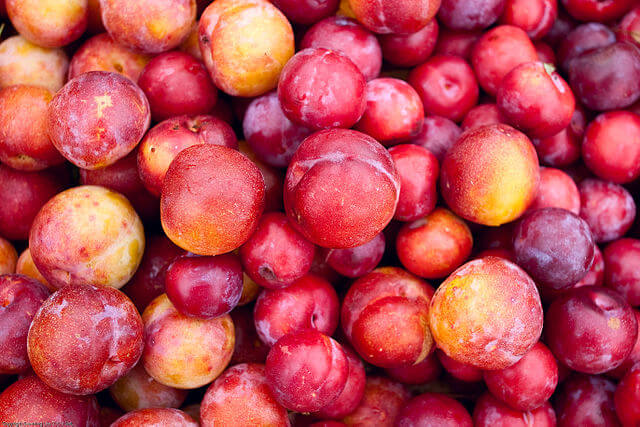
Plums are a great fruit to grow in San Francisco, California.
They are small stone fruits with various tastes, from sweet to tart.
The most common type of plums usually have purplish-red skin, but there are also ones with greenish-yellow skin.
But regardless of skin color, they have yellow flesh inside, which is usually juicy.
You can eat them fresh or use them to make jam.
Their juice can be fermented into plum wine or plum jerkum, an alcoholic beverage beloved in England.
Plums are also wonderful to plant because they are a great beauty; a plum tree in your garden is a splendid sight indeed.
They flower very quickly and are usually in season between May and December.
Ensure they are planted to get between six to eight hours a day, and then watch the magic happen.
2. Pluots (Plum & Apricot Hybrid, Sweet)
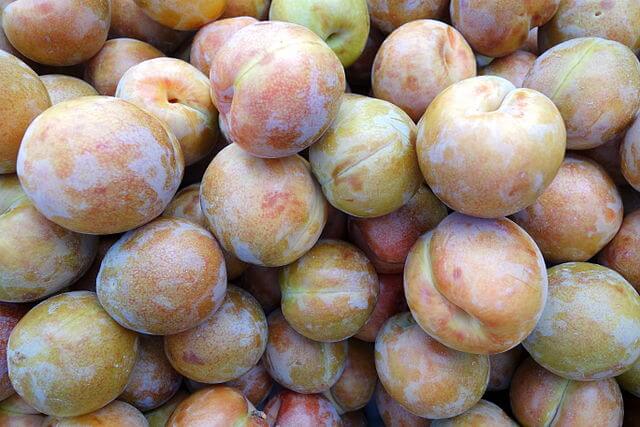
Chances are, you’ve never heard of pluots, and if you’ve ever seen them, you probably wondered what kind of fruit they were and why they looked so much like plums.
Like plums, pluots are from the stone fruit family.
They are a hybrid of plum (75%) and apricot (25%) developed in the ‘80s by an American farmer and geneticist named Floyd Zaiger.
You can eat them fresh like plums or bake them into pies and cakes.
Plums often leave a bitter taste in your mouth, but not pluots!
Pluots have an intense sweet flavor that will knock your socks off!
They are also a little less acidic than plums and are a great source of vitamins C and A.
Pluots have different varieties, like black kats, dapple dandies, flavor hearts, etc.
If you are going to plant pluots, note that they are usually in season between June and August.
3. Asian Pears (Apple-Shaped Pears, Sweet, Juicy)
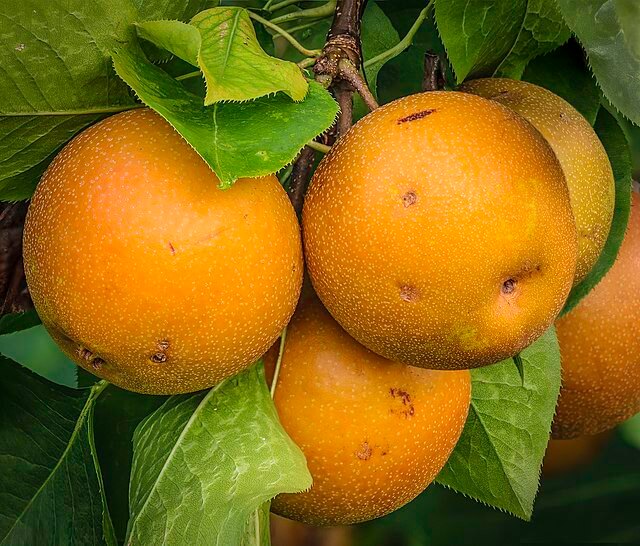
Hailing from East Asia, specifically Western China, Asian pears are apple-shaped pears.
Yes – they are pears, but they look almost exactly like apples.
They have skin colors ranging from pale bronze to greenish-yellow, with a slightly rough texture and evenly-spaced speckles.
Asian pears are the most popular fruit in Asia, dearly beloved in every household.
They came to California in the 1850s through some Chinese laborers and have since evolved several varieties.
You can eat them raw – their flesh is sweet, juicy, and crunchy like an apple, with tiny seeds in the middle.
Otherwise, you can enjoy them in salads or, as the Koreans love, in a therapeutic punch called baesuk.
When planting one, remember that it needs a lot of sunlight and usually takes longer than regular pears to fruit.
4. Lemons (Citrus Family, Rich in Calcium)
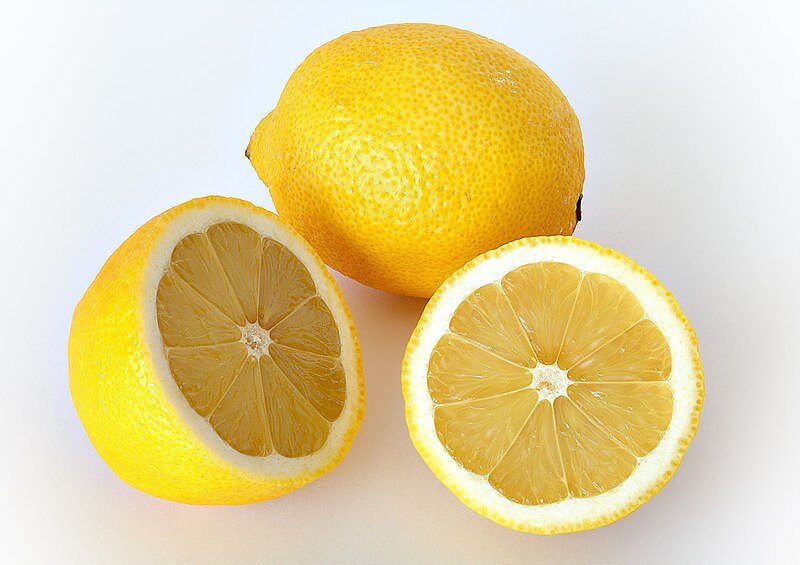
For most people, their relationship with lemons is complicated.
Bright and yellow, lemons are known for their intensely sour and acidic juice.
But they are also great to incorporate into food, producing fantastic flavors and health benefits.
So, as the famous saying goes, ‘When life gives you lemons, make lemonades.’
Lemons are another fruit that grows splendidly in San Francisco, California.
A member of the citrus family of fruits, they are a prevalent fruit despite the notorious sourness, grown far and wide.
It has yet to be determined where this glorious and enigmatic fruit originated initially.
Still, the earliest records trace it back 1000 to 1200 AD in Spain and North Africa before it spread into Europe in the 15th century.
Lemons are incredibly rich in calcium, especially potassium, which is crucial to the proper function of the body’s cells.
Also see our article on Ice Cream Shops in California.
Fruits to Grow in Fresno, California
1. Apricots (Sweet, Soft Skin, Yellow & Orange)
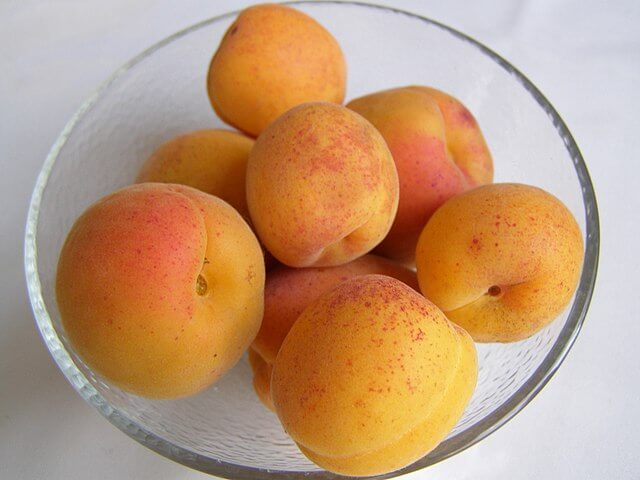
Apricots are a stone fruit to be grown in Fresno, California.
They usually have a sweet flavor, with soft and smooth skin in pale yellow or orange color and touches of red.
Apricots are small-sized, like plums.
They can be eaten raw or used to cook, giving your food a wonderful flavor.
Like plums, they belong to the botanical genus of Prunus, an essential member of the Rosaceae family.
Because apricots are highly perishable due to their softness, they are often picked when still quite unripe and firm to reduce damage during transportation to the market.
But if you have an apricot tree in your backyard, you can simply stroll in and pick them up when they are ripe and ready.
This is usually around June to August, depending on where you are.
Fresh and juicy is the best way to enjoy an apricot!
2. Nectarine (Smooth, Sweet, Small Size)
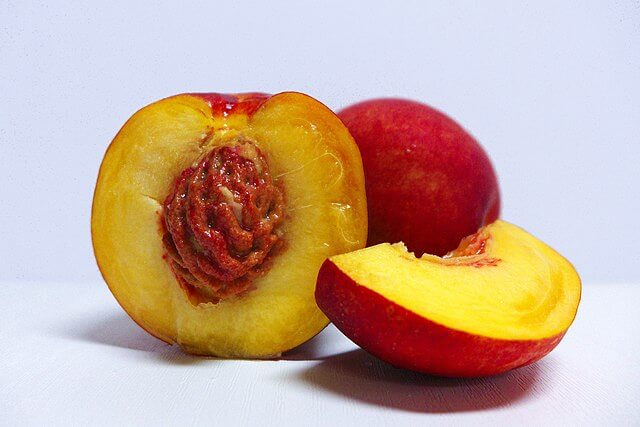
Another fruit that does very well in Fresno, California, is nectarine.
It is a sweet and juicy fruit similar to a peach, except that nectarines are smooth, whereas a regular peach has fuzzy skin.
Nectarines are a variety of peaches resulting from a difference in a single gene between one fruit and the other.
This single genetic difference is why their skins are smooth rather than hairy.
It also makes nectarines smaller and sweeter than peaches.
Sunlight is essential for their growth, and their skins are usually thick to protect them from pests.
California grows over 95% of all nectarines in the US, and Fresno is as good a place as any.
Nectarine is a great source of vitamins A, B3, and C.
They are also high in fiber, which controls blood sugar levels and increases lifespan.
3. Apples (Widely Enjoyed, Rich in Vitamins)
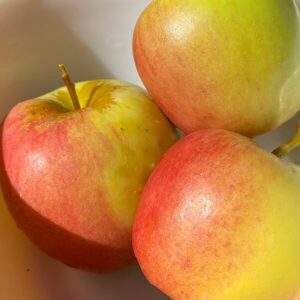
Apples are one of the most widely enjoyed fruits in the world.
They are loved and used for many things, from Japan to Germany to Mexico.
Yearly, the world produces about 76 million tons of this beautiful fruit.
China, Europe, Turkey, and the US are their main growing areas.
In the US, Fresno is a great place to grow apples.
Rich in several vitamins like vitamins A, C, E, and K, they are also a great source of potassium, copper, and other nutrients.
Apples are an all-stars-packed fruit; it’s little wonder why everyone loves them so much!
They are also sweet and crunchy, which is a great plus.
Research shows that they are a great help when you’re trying to lose weight, as they keep your hunger in check.
Apples also boost your brain health, so why not plant an apple tree today?
There is nothing but premium delight in store!
Also see our article on Flower Shops in California.
Fruits to Grow in Sacramento, California
1. Bananas (Widely Cultivated, Elongated Shape)

Bananas are one of the most important fruits in the world, and you can grow them quickly in Sacramento, California.
They are widely cultivated and eaten, ranking high amongst the world’s most commonly consumed fruits.
Not only do humans enjoy them, but they are also a favorite for animals like monkeys.
You know them for their elongated, phallic shape and soft, sweet flesh under a protective peel.
Depending on the type, their peels are usually green or yellow, but some varieties with red peels exist.
Bananas are a great source of essential nutrients like fiber, potassium, vitamin C, etc.
You can also incorporate them into fantastic recipes, like banana cakes, pies, and chips.
Babies are also quite fond of them, banana puree being a popular favorite of those tiny humans.
So if you have a baby, that’s all the more reason to grow bananas in your garden.
2. Olives (Small, Bitter, High in Nutrients)

Olives are another great fruit to grow in Sacramento, California.
This globally famous fruit grows on the Olea Europaea, or European Olive, a tree native to the Mediterranean Basin.
The Olea Europaea is the symbol of Mediterranean culture and an essential agricultural product for its fruits, olives, which are the source of olive oil, a core ingredient in Mediterranean cuisine.
Olives are tiny fruits from the broad family of stone fruits or drupes.
Unripe, they usually have green skin, but while some varieties quickly turn black when they ripen, others remain green.
The black varieties are more prevalent in the US.
Because they are very bitter, olives are usually not eaten raw but incorporated into meals.
They have great nutritional benefits, high vitamin E, calcium, iron, etc.
3. Citruses (Orange Family, Sweet, High Vitamins)
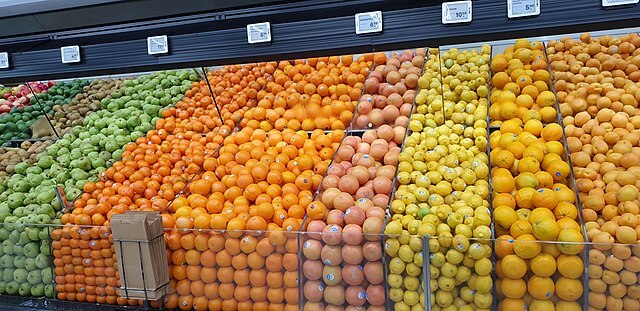
You can also be sure that citruses will do splendidly in Sacramento, California.
Citruses include a range of fruits from the Rutaceae (or orange) family, such as lemons, limes, oranges, grapefruits, etc.
Originally grown in the tropical and subtropical regions of southeast Asia, they are some of the longest-domesticated fruit crops in the world.
Botanically, they are a kind of berries (fleshy fruits with seeds rather than a pit in them, unlike stone fruits) believed by some to be the most widely planted fruits in the world.
Their plants can be either large shrubs or short trees conducive to picking.
They need between six to eight hours of sunlight daily and prefer to grow in humid environments.
Generally, citruses are usually peeled and eaten fresh.
Their juices range from sweet to tart and can be incorporated into several meals.
They are a great source of vitamins C and A and other essential nutrients.
4. Cherries (Small Red fruits, Sweet, Sour)
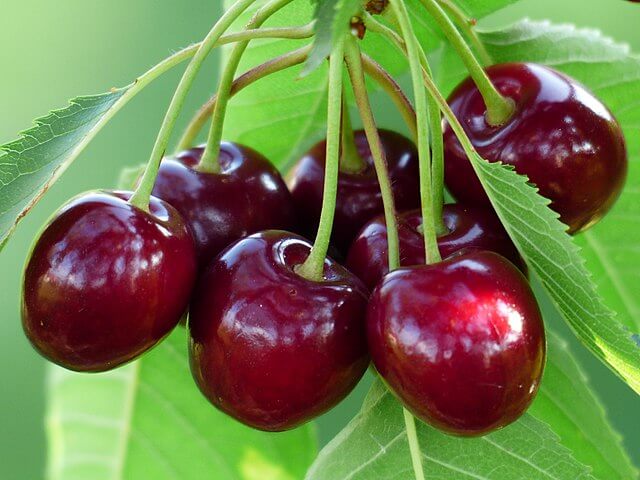
Cherries are small red fruits that grow on the Prunus Avium or the cherry tree.
Though they look like berries, they are drupes with a tiny pit in the middle.
They are known to have originated in the fertile lands of Asia Minor and likely found their way to Europe through birds.
Usually, their tastes range from sweet to sour and may have a woody or almond-like flavor.
They are low in calories and rich in fiber, vitamins K, A, and C, and other essential nutrients.
According to research, they are also great for athletes, helping with muscle damage, exhaustion, and pains.
Cherries like a cold environment to thrive and thus require a temperate region to grow.
Their growing season is relatively short, typically between May and July.
So if you intend to plant them, hurry up!
5. Figs (Ficus Carica, Sweet, Sunlight)

Fig is also a great fruit to be grown in Sacramento, California.
This strange fruit grows on the Ficus carica, a tree native to the Mediterranean region.
Figs don’t flower like regular fruits like apples.
Instead of blooming outside, their flowers bloom inside a pear-shaped pod and later mature to become the popular fig fruit.
Because of this, a particular wasp – the fig wasp – is responsible for pollinating the flower.
The relationship between the fig and the fig wasp is mutualism, as neither can exist without the other.
Figs taste like a blend of berries and honey and are a delightful palate experience.
They have smooth, soft skin, beneath which lies a sweet and slightly crunchy flesh.
To grow, they require a lot of sunlight and moisture-retentive soil.
Also see our article on Coffee Shops in California.
Fruits to Grow in San Jose, California
1. Peaches (Round, Sweet, Juicy, Originated China)

Peaches are a great idea if you are in San Jose, California, and plan to grow some fruits.
This excellent fruit has come a long way from China, where it is noted to have originated in.
According to records, peaches were only introduced to the Western world 2000 years ago.
They came into America in the mid-16th century, courtesy of some Spanish monks around Florida, and have spread quickly ever since.
Peaches are small, round fruits with a skin of pale, pink-orange color covered by little furs.
They have a sweet, juicy yellow flesh beneath their skin and can usually be enjoyed raw, baked, or incorporated into other meals.
Eating peaches is especially great for your heart, as it may reduce the chances of diseases.
Because they are stone fruits, they have a small pit in the middle in which their seeds are contained.
You must break the pit to extract the seed to plant a peach tree.
2. Pomegranates (Round, Red, High Antioxidants)

Pomegranates are another fruit that does well in San Jose, so you may want to consider them.
Called the fruit of the dead in Greek mythology because it leads Persephone to the underworld; this is a small, round, and red fruit with sweet or tart flesh.
The thick skin is often peeled away to get to the flesh beneath.
However, though inedible, you need not discard this skin, as you can dry and grind it into a fine powder which is excellent for treating some skin conditions like acne.
The pomegranate is an ancient fruit initially grown in the Mediterranean region.
It has a low-calorie count but is high in fiber, vitamins, and especially antioxidants which help to protect the body’s cells.
When planting a pomegranate tree, remember it needs a lot of sun and well-drained soil.
The fruit usually matures between March and May.
3. Grapes (Round, Fleshy, Various Colors)
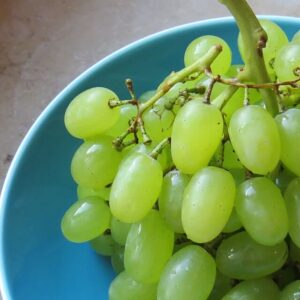
Grapes are one of the most common fruits around: they are found in most countries worldwide.
They are round and fleshy, growing in clusters of tiny fruits of green, yellow, or purple colors.
Their tastes can range from sweet to tart to salty to bitter.
Most grapes are eaten raw, dried, or incorporated into meals by extracting their essence.
Some varieties are used for making wine.
Grapes started being cultivated around 7000 BC between Iran and the Black Sea.
This fruit is an excellent source of vitamins B and K and typically grows on vines.
They are high in antioxidants, which may protect you from some types of cancer and are also great for the eyes.
If you consider planting them, note that they require well-drained soil and usually ripen between summer and late autumn.
4. Jujubes (Chinese Date, Sweet, Dried Snacks)
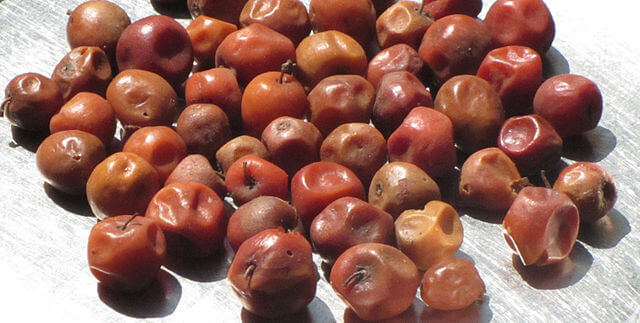
Also known as Chinese date, jujube is another fruit that can be grown in San Jose.
This tiny round fruit is native to Southern Asia but is beloved worldwide.
They were first domesticated around 9000 BC and have since then evolved several varieties.
Jujubes are sweet and can be eaten raw or dried to make them chewy, like dates.
When ripe, they are dark red or purple; inside them is a pit.
Eaten fresh, they are known to taste like apples, but when dried, they taste more like dates.
Dried jujubes are a great snack to be tossed into your mouth as you go about an activity.
Just keep in mind to avoid the pit in the center.
They are rich in vitamin C and may help improve the quality of your sleep and brain function.
Remember that they are best planted in late spring and can start yielding as early as the second year.
Also see our article on High Tea in California.
Fruits to Grow in San Diego, California
1. Grapefruits (Citrus Fruit, Sweet-Tart Juice)
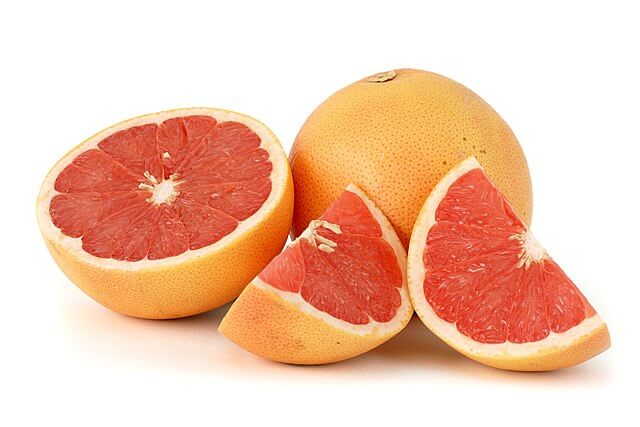
Are you in San Diego and looking for a fruit to grow?
Grapefruits are a great idea!
They are a kind of citrus fruit known for their sweet-tart juice.
A natural, accidental hybrid of pomelo, another citrus fruit native to Southeast Asia, and oranges, they are large and have a thick peel.
Their skin ranges from gold to green; their flesh can be yellow or crimson.
Grapefruits are known to have come from Barbados in the 17th century.
Eaten raw, grapefruit is one of the healthiest fruits to eat, as it is low in calories.
It is excellent for your immune system and can also help with weight loss.
Grapefruit trees need at least six to eight hours of sunlight daily and typically bloom in April or May.
2. Loquats (Small, Round, Juicy, Medicinal Tea)
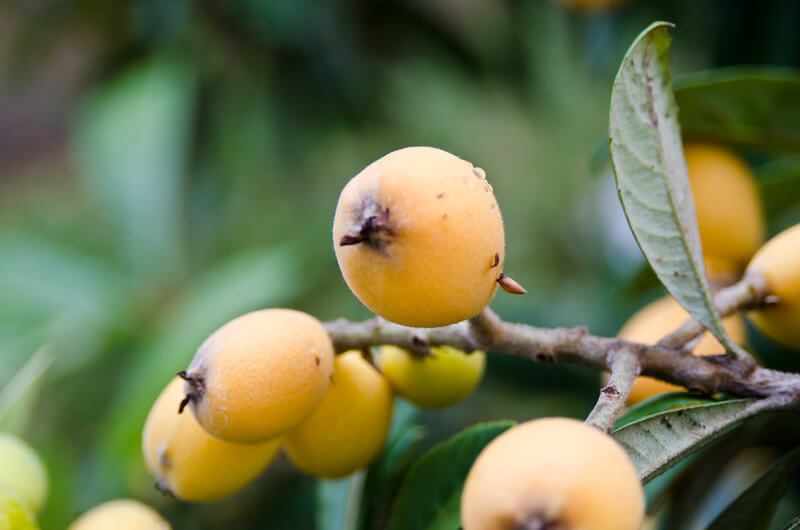
Loquat is another fruit you can grow in San Diego, California.
Native to China and a member of the rose family, it is small and round and grows in clusters.
It has yellow or red-orange skin, and its flesh is juicy, ranging in taste from sweet to tart.
Being a stone fruit, it contains several ovules in the middle.
Otherwise called nisperos, loquats are delicate fruits that are best not grown commercially.
They are more of a rare, homegrown, backyard kind of fruit, and their tree and leaves are of great value.
The leaves can be used to make loquat leaf tea, which has great medicinal uses.
When growing them, ensure that they are positioned to have full access to the sun; otherwise, the fruits may not ripen fully.
Typically, they bloom in the fall and early winter.
Also see our article on Bakeries in California.
Fruits to Grow in Stockton, California
1. Melons (Cucurbitaceae Family, Sweet, Juicy)
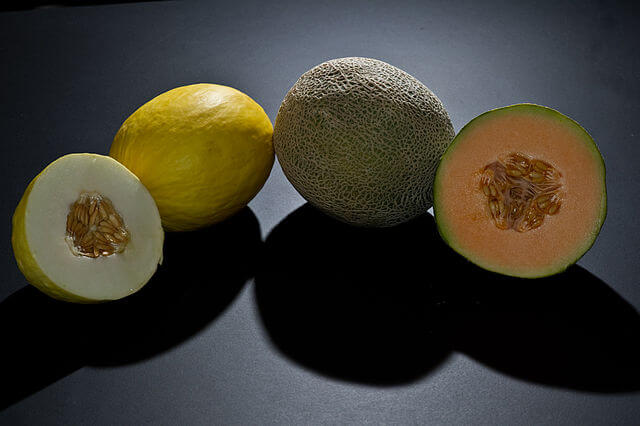
For Stockton, California, residents who want to grow fruits, melons are great to try out.
They include various fruits in the Cucurbitaceae family, like watermelon, cantaloupe, winter melon, etc.
Classified as a berry, specifically of the pepo type (for their firm, tough rinds), these fruits are native to intertropical Africa and Southwest Asia.
They were one of the earliest plants to be domesticated in the Old World and among the first to be introduced to the New World.
Melons are round, usually large fruits with rind colors ranging from yellow to green, and often combined.
Beneath the rind, their flesh is sweet, juicy, and aromatic, of white or orange color.
They are low in fat and cholesterol and a great source of fiber, potassium, and vitamins K, C, and B6.
2. Tomatoes (Botanical Berries, Various Colors)

Tomatoes are also a great fruit to grow in Stockton, California, as you can be sure they will do very well.
Originally from South and Central America and Mexico, they have spread worldwide, becoming a staple in most homes.
There are several varieties of colors ranging from red to yellow to green to purple.
Each variety has its unique texture and flavor, the most common being cherry, grape, and Roma tomatoes.
They are botanically classified as berries, with thin, fleshy skin covering sweet-tangy flesh beneath.
You can eat them raw, but they are mainly used for culinary purposes, serving as an essential ingredient in many dishes worldwide.
There are numerous health benefits attached to eating tomatoes; they help reduce the risk of heart disease and even cancer like prostate cancer.
When planting them, note that they require warm weather, well-drained soil, and constant watering.
Also see our article on Pizza in California.
Fruits to Grow in Santa Barbara, California
1. Mulberry (Morus Tree, Sweet, Improved Circulation)

Santa Barbara provides excellent growing conditions for mulberries.
Though they come from the Morus tree, a deciduous tree native to Asia, they have been widely cultivated worldwide.
Mulberries have been enjoyed for centuries; they grow in clusters of small, long, and fleshy fruits with tiny seeds and can be snacked on both fresh and dried.
You can incorporate them into several meals like salads, muffins, fruit bars, etc.
Mulberries are sweet and slightly tart, and they come in purple or black when fully mature.
Regularly consuming mulberries have been linked to improved blood circulation in the body, as well as brain and liver health.
In Asia and North America, they are grown for their leaves to feed silkworms which produce silk.
Mulberry leaves are the only thing silkworms can eat, so mulberries are also crucial to producing silk.
2. Pistachio (Drupe, High Protein, Fiber)
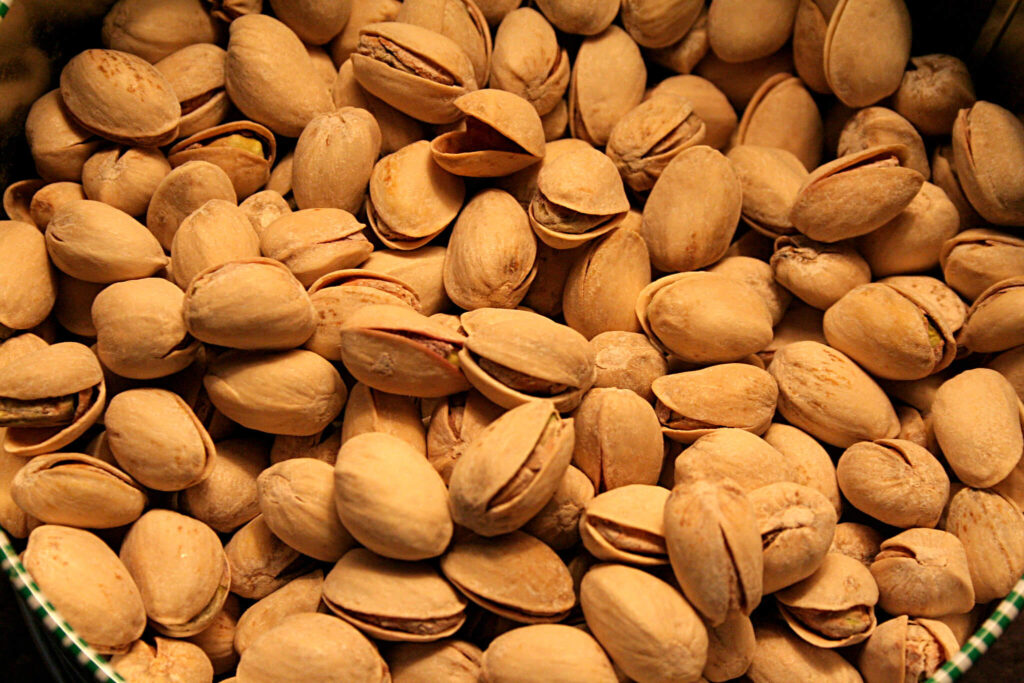
You can also grow pistachio in Santa Barbara, California.
This fruit was first grown millennia ago in the Middle East but has now spread worldwide and has been widely cultivated in countries like Greece, Turkey, and the US.
Though easily mistaken for a kind of nut because of its hard shell, it is a drupe, a fleshy fruit with a pit in the middle in which the seed is contained.
It’s just that with pistachios, the fleshy part is usually neglected for the more delicious seed inside the pit.
This seed can either be eaten raw or roasted as a snack or used as an ingredient for certain meals.
Eaten raw, it typically has an earthy flavor and can either be soft or hard, depending on its stage of maturity.
It is an excellent source of protein, fiber, and healthy fats and may help reduce the risk of diabetes.
If you’re growing them, note that they require a lot of sunlight and well-drained soil.
3. Nectaplum (Nectarine & Plum Hybrid, Sweet, Easy Grow)
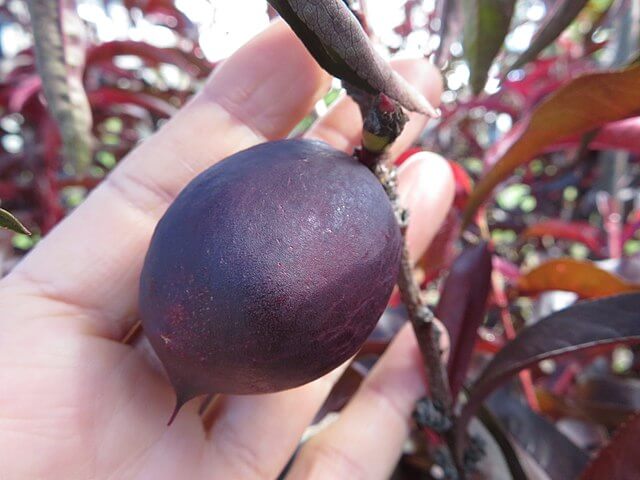
Nectaplums are a relatively recent fruit that grows splendidly in Santa Barbara.
Developed only in the late 20th century by Floyd Zaiger, a genius American fruit breeder, they are a hybrid of nectarines and plums, which heavily influence the taste of nectaplums.
The flesh of nectaplums is sweet (with a bit of acidity) and juicy and is covered by a skin of bright maroon color.
Like its parent fruits, nectaplum is a drupe that can be eaten fresh or incorporated into meals.
You can eat nectaplums for their vitamins (C & A), fiber, potassium, etc., and to improve your body’s metabolism.
An interesting thing to note is that nectaplums were first developed within the very borders of California.
They are easy to grow and flower so beautifully that they will take your breath away!
If you liked this article, you may also like to read about the best Seafood Restaurants, Italian Restaurants, and Chinese Restaurants in California.
